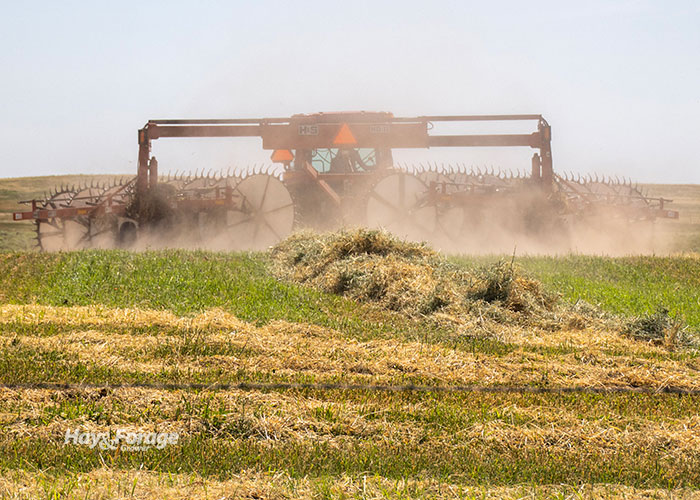
Dry weather — to varying degrees — has beset a large swath of the U.S. during the beginning of the 2023 haymaking season. In the Midwest, I have never seen so much first-cutting hay get baled instead of chopped. Further, the hay was baled in a timely manner with quality limited only by the ability to retain leaves.
An extreme lack of rainy days poses a double-edged sword. On the one hand, haymaking is undeterred by weather; on the other, regrowth is restricted by the lack of moisture. Another less obvious downside to dry soil conditions is . . . well . . . dry soil conditions or dust, which more easily finds its way into harvested forage.
It’s well known that the growing environment can impact the quality of forage. Cool temperatures generally are favorable for improving fiber digestibility, hot temperatures will speed plant maturity, persistent precipitation will delay harvest, and rain on a wilting crop will leach out desirable nonstructural carbohydrates.
Haymaking is, pure and simple, a weather game.
Dusty conditions enhance the likelihood that dry soil will find its way into harvested hay or haylage. Once in the forage, we call it ash. Forage ash content is effectively the sum of two primary sources. The first is the minerals that are inherent in the plant — components such as calcium, phosphorus, potassium, and magnesium. We normally regard these as essential and beneficial to both plant and livestock health. Typically, these minerals comprise about 8% of the dry weight for alfalfa and 6% for grasses.
The other component of forage ash content is external soil contamination, primarily silica. This is the stuff that was once used to grow forage but becomes a part of the feed. The likelihood of picking up soil between cutting and storing forages is enhanced by the type of conditions many of us have experienced in 2023.
While silica isn’t necessarily toxic to an animal, it does take the place of more desirable energy-dense nutrients on a one-to-one basis. Ash or minerals contain no protein, calories, energy, or nutrients that cattle can ferment in their rumens. As one dairy nutritionist once said, “We don’t know exactly what the impact of eating dirt is, but it can’t be good.”
Soil contamination also carries the risk of introducing undesirable fermentation microorganisms such as clostridium to the forage. This can be especially problematic in baleage.
How much is too much?
Ash content often ranges from about 5% to 18% when a large data set of both grasses and legumes are analyzed. Values trend on the lower end of that range for grasses and dry hay samples and are generally higher for haylage. Although it’s impossible to keep all soil contamination out of harvested forage, a good maximum value to aim for is 11%, or about 3% external soil contamination in the case of alfalfa.
Unfortunately, high forage ash content is not just aggravated by dry weather and dusty conditions like we’ve seen this year. It can also elevate when soils are wet and muddy. Heavy rains have the potential to splash soil particles onto forage, especially if the forage is lodged. Factors such as rodent holes, previous flooding, and gravel roads will also contribute to higher ash values in localized field areas.
The greater attention to ash content has now led most forage laboratories to offer a neutral detergent fiber (NDF) analysis that is ash-free. This is designated as NDFom or aNDFom on a forage analysis report.
To demonstrate the economic significance of ash, consider a ton of 100% dry matter alfalfa. There will be about 160 pounds of plant mineral in the ton of hay (2,000 pounds x 0.08). Every 1% bump in ash content above 8% equates to adding about 20 pounds of soil. As such, alfalfa with an ash content of 13% will contain 100 pounds of soil per dry matter ton.
You can help
Although it’s impossible to harvest “dirt-free” forage, there are proven practices that will minimize forage ash content when conditions are excessively dry or wet. They include:
1. Raise the cutting height. Though a low cutting height offers a higher yield potential, it also results in more soil being incorporated into the forage.
2. Make wide swaths. This will not only speed up the drying rate, but it will also keep the wilting forage on top of the stubble and off the ground.
3. Use flat knives on disc mowers. These will create less suction and introduce less soil into the forage than angled knives.
4. Make sure rakes and tedders are properly adjusted. The goal is to move the forage, not the soil. University of Minnesota research showed that wheel rakes tend to incorporate more ash into the forage than other rake types.
5. Rake as little as possible. Often, the crop must be raked, but use strategies that minimize hay movement over the ground. Mergers are much more effective in this regard as the hay is picked up before being moved.
6. Control rodents. In addition to the damage they do to fields and plants, dirt mounds are easily incorporated into forage windrows.
7. Keep storage areas clean. Soil can be added at the storage and loading site as easily as in the field. Keep silage bags and silo piles on well-drained, solid surfaces.

